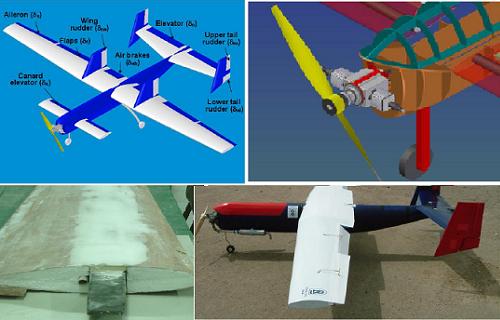Tal Inbar, the messenger of the website for the 45th Aviation and Space Conference

Direct link to this page: https://www.hayadan.org.il/CHAMELEON0205.html
At the forty-fifth annual Israeli meeting of the Israel Aerospace Sciences Association, held last week in Tel Aviv and the Technion, a prize was awarded for outstanding work in the student project competition. A group of fourteen students from the Technion's Faculty of Aeronautics and Space Engineering, led by Shlomo Tzach from the Aerospace Industry, won an award for the final project they submitted - a flight simulator to test different aerodynamic configurations - in flight.
The unmanned aerial vehicle designed by the students is called CHAMELEON for its ability to imitate the dynamic behavior of various types of unmanned aerial vehicles. The original pilot's vehicle has a variable stability (achieved by using a very large number of steering and steering surfaces) that allows it to successfully imitate most of the small and medium-sized UAVs in use in the world. The students were engaged in the instrument high school, in complex simulations of efforts, forces and flow, and built the aircraft - whose wingspan reaches four meters.
The idea behind the project is an examination of flight characteristics under real conditions - and not in computer simulation, which despite the great development in the field of simulations and graphic computers for heavy applications, does not allow the prediction of all the parameters that the planners wish to examine.
The solution presented by the students - building a plane without a pilot, with plenty of aerodynamic control surfaces, which can imitate the behavior of various drones that are in the planning stage, and perform real flights in which parameters planned for other drones will be tested. Carrying out these test flights can save a lot of money on the one hand, and discover certain secondary defects on the other hand - defects that may escape the detection and identification ability of various imaging software used by the aeronautical industries.
On 30.4.2004/XNUMX/XNUMX, the innovative pilot took off for the first time into the air. He has made several test flights since then, proving his high school readiness and living up to expectations. Additional test flights should be conducted with additional control surfaces installed in the vehicle, in order to expand its ability to imitate in flight the flight data of other unmanned aerial vehicles.
The concept of in-flight simulation has been known in the world for years, at the same time it is quite rare, however in-flight simulation for UAVs (unmanned aircraft) is not known and the idea of the students from the Technion is original and interesting. At the conference, the students presented the pilot tool itself, as well as a presentation detailing the rationale of the project and the methods of its implementation.
One of the factors hindering the continued development of the "chameleon" is the lack of an advanced flight control system in the aircraft. At this stage, the Technion has no intention of continuing the project with new students, but it is possible that the resources required to continue the flights and crack the tool will be raised by other parties related to it.
In a conversation I had with Professor Dan Gaboli, Dean of the Faculty of Aeronautics and Space Engineering at the Technion, the close relationship between the faculty headed by him and the aerospace industry came up. According to Professor Gavoli, the practical experience of students nearing the end of their studies at the Technion with the real world represented by the industry excites them greatly, and also allows the industry to "use" the students to examine various ideas put forward by the people of the aerospace industry.
The aerospace industry sees the relationship with the students as an investment in the future, said Professor Gavioli. He noted that the defense industries and other knowledge-intensive industries compete for the graduates of the faculty he heads, first and foremost because of the multifaceted and interdisciplinary nature of the Technion curriculum. "Many of the system engineers in aerospace projects come from Technion graduates," he said.
* Tal Inbar is a researcher at the Fisher Institute and vice president of the Israel Space Association
Yadan includes Tal Inbar's articles
The aviation connoisseur
https://www.hayadan.org.il/BuildaGate4/general2/data_card.php?Cat=~~~94404328~~~183&SiteName=hayadan
